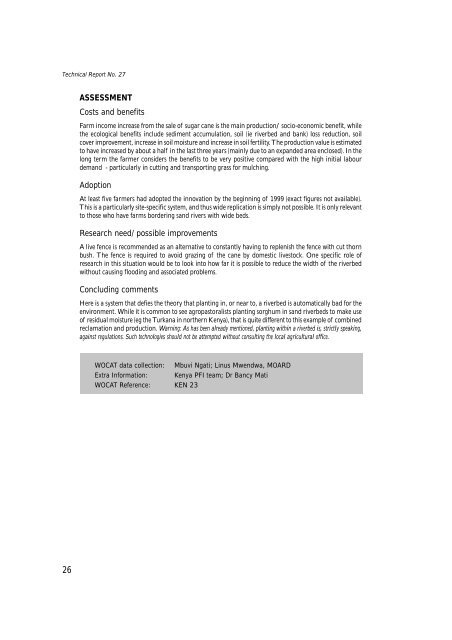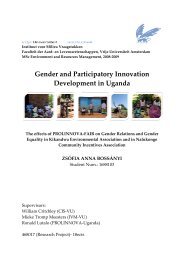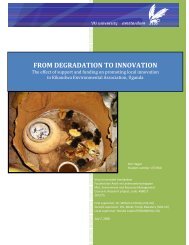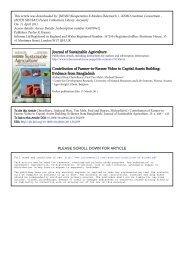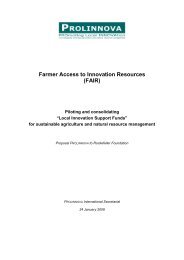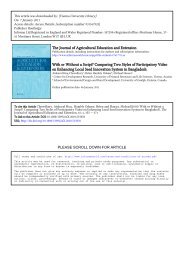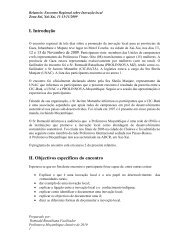Farmers' initiatives in land husbandry: promising ... - Prolinnova
Farmers' initiatives in land husbandry: promising ... - Prolinnova
Farmers' initiatives in land husbandry: promising ... - Prolinnova
Create successful ePaper yourself
Turn your PDF publications into a flip-book with our unique Google optimized e-Paper software.
Technical Report No. 27<br />
ASSESSMENT<br />
Costs and benefits<br />
Farm <strong>in</strong>come <strong>in</strong>crease from the sale of sugar cane is the ma<strong>in</strong> production/ socio-economic benefit, while<br />
the ecological benefits <strong>in</strong>clude sediment accumulation, soil (ie riverbed and bank) loss reduction, soil<br />
cover improvement, <strong>in</strong>crease <strong>in</strong> soil moisture and <strong>in</strong>crease <strong>in</strong> soil fertility. The production value is estimated<br />
to have <strong>in</strong>creased by about a half <strong>in</strong> the last three years (ma<strong>in</strong>ly due to an expanded area enclosed). In the<br />
long term the farmer considers the benefits to be very positive compared with the high <strong>in</strong>itial labour<br />
demand - particularly <strong>in</strong> cutt<strong>in</strong>g and transport<strong>in</strong>g grass for mulch<strong>in</strong>g.<br />
Adoption<br />
At least five farmers had adopted the <strong>in</strong>novation by the beg<strong>in</strong>n<strong>in</strong>g of 1999 (exact figures not available).<br />
This is a particularly site-specific system, and thus wide replication is simply not possible. It is only relevant<br />
to those who have farms border<strong>in</strong>g sand rivers with wide beds.<br />
Research need/ possible improvements<br />
A live fence is recommended as an alternative to constantly hav<strong>in</strong>g to replenish the fence with cut thorn<br />
bush. The fence is required to avoid graz<strong>in</strong>g of the cane by domestic livestock. One specific role of<br />
research <strong>in</strong> this situation would be to look <strong>in</strong>to how far it is possible to reduce the width of the riverbed<br />
without caus<strong>in</strong>g flood<strong>in</strong>g and associated problems.<br />
Conclud<strong>in</strong>g comments<br />
Here is a system that defies the theory that plant<strong>in</strong>g <strong>in</strong>, or near to, a riverbed is automatically bad for the<br />
environment. While it is common to see agropastoralists plant<strong>in</strong>g sorghum <strong>in</strong> sand riverbeds to make use<br />
of residual moisture (eg the Turkana <strong>in</strong> northern Kenya), that is quite different to this example of comb<strong>in</strong>ed<br />
reclamation and production. Warn<strong>in</strong>g: As has been already mentioned, plant<strong>in</strong>g with<strong>in</strong> a riverbed is, strictly speak<strong>in</strong>g,<br />
aga<strong>in</strong>st regulations. Such technologies should not be attempted without consult<strong>in</strong>g the local agricultural office.<br />
WOCAT data collection: Mbuvi Ngati; L<strong>in</strong>us Mwendwa, MOARD<br />
Extra Information: Kenya PFI team; Dr Bancy Mati<br />
WOCAT Reference: KEN 23<br />
26


